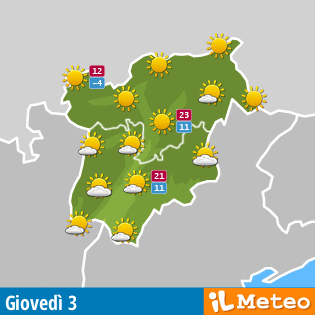Carnivals
The Masquerade of Dolomites
 |
| Italian |

Attending to the Carnivals meens going back in time, enjoying almost unknown colors, feeling ancient emotions, but for us, modern people, new. Knowing this tradition means to discover the mountain in its most intrinsic meaning, as if you took of the vests of citizens and of man of the modern era, to see and feel what the inhabitants of the mountain valleys feel, and especially how they felt in the most difficult times, when the roughness and the difficulties of life in the mountains were expressed through these rites, as if they were poetry and drama, as if it could be shaken off, at least in some festive days the difficulties, representing the joy, but without forgetting the harshness of life. In fact, a common feature of all of these representations is the duality between beauty and ugliness, joy and difficulties of living as a wonderful mysterious masquerade of life and death. This could be an explanation for this peculiar tradition.
As in many other areas of the Alps, even in the Dolomites, have been preserved up to our days the typical masquerades, reminiscences of archaic traditions, which have mostly survived in the mountain areas, where the influence of the dominant culture and cultural news occurs more slowly and more damped.
Here after will be told the main Dolomitic Carnivals, although the best way to experience and learn about colors, feelings and meanings of these festivals is to participate in first-person.
Masquerade of Comelico Superiore
This traditional event takes place in the four hamlets of Upper Comelico in the province of Belluno, the most northern area of Comelico: Padola, Dosoledo, Candide and Casamazzagno. The most felt and characteristic is the Dosoledo carnival, where each February the 9th (Santa Apolonia) takes place the traditional masquerade. In the other towns, although the representation is the less important, the parade is held every year, except in the tiny hamlet of Casamazzagno, where it’s possible to organize the parade only in rare cases (in 2011 was interrupted a break in the representation for more than ten years).
The masquerades of Comelico Superiore have a very complex organization and that repeats itself year after year, which is basically the same, except for slight differences in each fraction. The parade is divided into two masks categories: the mascri by bela (beautiful masks) and the mascri da vecia (old masks), as to represent the two sides of life, the joy and the hard way. In addition to these masks there are some typical characters: the Matazin, the Paiazu, the Lachè, absent in Candide and Casamazzagno and Matazera, absent in Casamazzagno. The Matazin is the most important carnival mask of the comelico, the one who leads the procession, and is characterized by colorful robes and a tall hat which is also brightly colored and decorated with sequins and buttons. The Lachè, if any, is very similar to the Matazin, and is characterized by some little differences in the mask so slight that, for a non-expert, it becomes virtually impossible to distinguish them. At each procession must be present at least two Matazins or a Matazin and a Lachè. The number may even be higher, but these main masks must always be equal in order to make the typical dance. The Matazins must always proceed dancing and characteristic is the time of the jump, when the two masks, one facing the other, make a jump as higher as possible.
Sappada Carnival
Unlike the Comelico Superiore, characterized by the joy transmitted by Matazins, in Sappada there is more austere but equally magnificent between these traditions. The period of the carnival celebrations, in this German language island, is very long. In Sappada the event (Plodar Wosenocht) is divided into six days. The three Sundays which precedes the Lent is characterized by a masquerade: the first is the Sunday of the poor (Pettlar Suntag), the second is the Sunday of the peasants (Paurn Suntag) and the last one is the Sunday of the lords (hearn Suntag). Different characteristics from most of the Dolomites and the Alps Carnevals is therefore the representation of different social classes (and different aspects of life as well as emotional, and as generational aspects) not in the same masks (such as it occurs in the Comelico event) but in different masks.
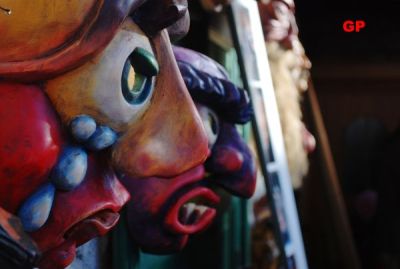 |
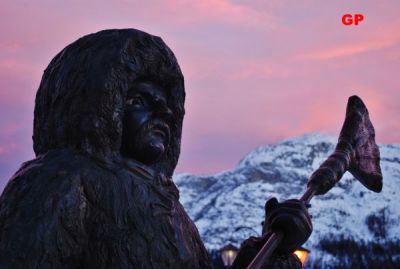 |
In Sappada is still very important to remain anonymous, so all the participants of the parade wear the characteristic wooden mask, the Lorve. The most important mask of this masquerade is the Rollate or Rollat. This is a different mask from almost all traditional masks of the Belluno mountain (has only slight similarities with the Ber Agordino), while it has more similar traits with some of the carnivals masks from the Tyrolean and the Friulian areas. The Rollate is an imposing mask, so it must be "dressed" by a strong man.
The dress consists of a brown sheepskin fur coat with a large hood, with knotted a handkerchief (white for single men and red for married men). The shorts are baggy, striped brown and white, taken from the Hille, the canvas which covers the cattle during the winter. Related to the waist there are heavy bronze spheres (rollen) that at each step ring with a characteristic noise. This, in the austerity of the carnival is the only sound. Austere is also the wooden mask with bushy mustache and eyebrows, which hides all day the identity of the mask. The Rollat is a "spiteful" mask who "abuses" viewers, threatening them with the characteristic broom, and speaking in the quaint language of the place, always to conceal the identity of the man behind the mask. If have disappeared figures once present, as the Clown and the Better montl since 1995 have appeared as new masks, two Schroate (the bogeyman for the children of the night shadows), characterized by a dark coat, hood, face mask made by bark, twigs of pine on the legs and unpredictable behavior and sometimes aggressive.
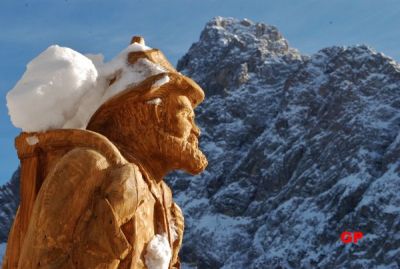 |
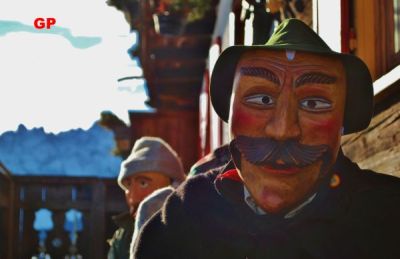 |
These are not the only masquerade, other more or less famous revive ancient traditions, such as the Carnival of Fornesighe in the Zoldana valley or in Lozzo di Cadore and in Fassa Valley. All evidences of a past sometimes even recent but that re-rooted ancient themes in the dolomiti mountains valleys.
The photographs accompanying this page were offered by our friend
Giuseppina Pinazza
